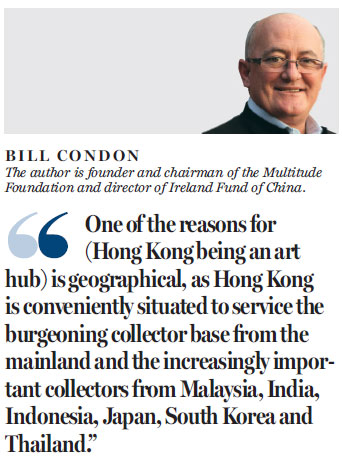SAR can serve as a key player in the international art world
Updated: 2016-04-25 07:47
By Bill Condon(HK Edition)
|
|||||||||
The glitterati of the art world recently descended upon the territory for the fourth edition of Art Basel Hong Kong, Asia's premier art fair. Intelligently supported by the second edition of Art Central and a smorgasbord of shows and exhibitions catering for every appetite and budget, art was everywhere.
The burgeoning international art circus attracts the rich, the super rich, the famous, the great and the good, all of whom created quite a buzz around the five-star hotel lobbies and Michelin-star dining rooms of Hong Kong. Artists, collectors, curators, gallerists, museum directors, trustees along with the myriad of associated supporters were on full view and there was a palpable sense of excitement. The best judge of success remains sales and in the midst of spluttering global markets, weak economic data and even weaker forecasts it was very encouraging to learn of strong sales throughout the week. The presence and the activity of the increasing numbers of private Chinese museums provided much needed financial justification for the galleries to participate.
Following Art Basel Hong Kong's first days of VIP viewings, exclusive parties and private dinners, upwards of 70,000 people savored the carefully curated offerings from 239 of the world's leading galleries spanning 35 countries. Many are becoming familiar faces here as they make the annual pilgrimage to service their rapidly increasing Asian collector base.

Art Central boasted over 100 galleries, around three quarters of which were Asia-based and had a noticeably edgy feel. The impressive list of galleries complemented an ambitious program of discussions, installations, performance and film. Reports suggested that footfall was higher than the previous year, sales were good and the quality of artworks on offer had improved.
Hong Kong Art Week has become one of the most anticipated events on the city's cultural calendar and it delivered in every sense, bringing visitors, increasing the territory's profile as an art destination and generating much-needed revenue. It provided a great opportunity for the public to witness the best as well as the darlings of the international art world.
The star-studded line-up attending the shows included a plethora of Chinese artists, many of whom have joined the ranks of the very rich, as well a smattering of showbiz stars, perhaps the most notable being Leonardo DiCaprio. Another of the highlights from Art Basel Hong Kong was former British enfant terrible Tracy Emin having a very forthright discussion with David Tang.
All of this ongoing activity has firmly established Hong Kong as a key market player within the international art circuit and positions the territory center stage in terms of Asia.
One of the reasons for this is geographical, as Hong Kong is conveniently situated to service the burgeoning collector base from the mainland and the increasingly important collectors from Malaysia, India, Indonesia, Japan, South Korea and Thailand. The city also has the infrastructure required to support the art ecosystem and enable it to function efficiently. The arrival of a number of the larger international galleries over recent years and an active auction market further stimulates the increasingly important regional collector base and strengthens Hong Kong's influence.
A strong sense of optimism characterized the run-up to Sotheby's spring sale along with an overriding belief in certain quarters that quality art pieces somehow represent good value. This translates into an increasing number of buyers viewing art as an alternative asset class - one that can enable them to spread investment risk and generate solid returns. Happily on rare occasions this indeed can be the outcome, but it certainly is not a guaranteed one and it is not an advisable route for the average investor to pursue.
The subsequent auction notched up some remarkable sales and capped off a great spring performance for Hong Kong. The highlight was Zhang Daqian's Peach Blossom Spring, which was the top lot and sold for HK$271 million - a record for the artist at auction. This was bought by none other than Liu Yiqian from Long Museum, Shanghai, bringing yet another trophy piece back to the mainland.
One of the most notable highlights for the people of Hong Kong was a very poignant light installation on the facade of the ICC, created by Japanese artist Tatsuo Miyajima. Time Waterfall digitized a cascade of falling numbers, ranging from nine to one, representing a countdown to death or the meaning of life.
(HK Edition 04/25/2016 page11)